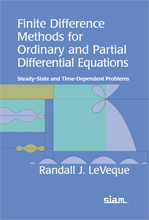|
|
| General information |
|---|
Instructor:
Malgorzata Peszynska
Class:
MWF 10:00-10:50 Gilkey 115
Course information:
CRN 27062. Credits: 3.00.
Student preparation: I expect the students to have a good
background in differential equations (students registered for MTH 452
should have taken 256 or equivalent). Familiarity with (some)
numerical methods, algorithms, some programming language, and in
particular with MATLAB is a plus; however, I will develop the basics
as necessary. Most students will have taken 451/551 prior to this
course but this is not mandatory: please contact me if you have
questions.
Syllabus: In the course we will cover the
following topics:
- Review of basic information about solving differential equations.
- Difference methods for IVP (Initial Value Problems) including
one-step and multi-step methods, explicit and implicit methods, their
combinations, predictor-corrector methods. You will become familiar
with methods associated with names of Euler, Runge-Kutta,
Adams-Bashforth, Adams-Moulton, and others.
- Properties of numerical methods for IVP: their stability,
consistence, convergence, rate of convergence, and cost. You will
understand the dilemma between accuracy and efficiency. You will learn
how to improve stability of a method at a reasonable cost which is
especially important in the context of stiff problems.
- Examples of relevant ODEs from applications. You will get
computational experience in solving them numerically and enjoy
discovering their properties using numerical experiments.
- Additional topics may include introductory material on BVP
(boundary value problems) solved with shooting methods and finite
differences.
Textbook:

|
Finite Difference Methods for Ordinary and Partial Differential Equations, Steady State and Time Dependent Problems
by Randall J. LeVeque,
SIAM, 2007. Paperback: ISBN 978-0-898716-29-0
Exercises and m-files to accompany the book
Enrichment material will be introduced from Ascher/Petzold
Numerical Solution of Ordinary Differential Equations ,
Ascher, Mattheij, Russell, Numerical Solution of Boundary Value
Problems for Ordinary Differential Equations,
Numerical Computing with MATLAB by Cleve Moler (SIAM, 2004).
Scientific Computing by Michael T Heath, also from the
numerical analysis classic by Stoer and Bulirsch [SB] and from other
resources.
MATLAB materials: there exist plenty of good resources for
MATLAB, some available online (search, for example, for "matlab
tutorial free").
|
Exams: There will be a Midterm in class on Friday, Feb.8, and a Final Exam
on Tuesday, March 18, at 9:30am.
Grading: Homework will count as 40% of the grade, exams as
30% each. Additionally, problems for extra credit (for the total up
to 10%) will be assigned throughout the term as Homework and/or during
Final exam.
Special arrangements for students with disabilities,
make-up exams etc.: please contact the instructor and Services for Students with
Disabilities, if relevant, and provide appropriate
documentation.
Course drop/add information is at
http://oregonstate.edu/registrar/.
|
|
|

